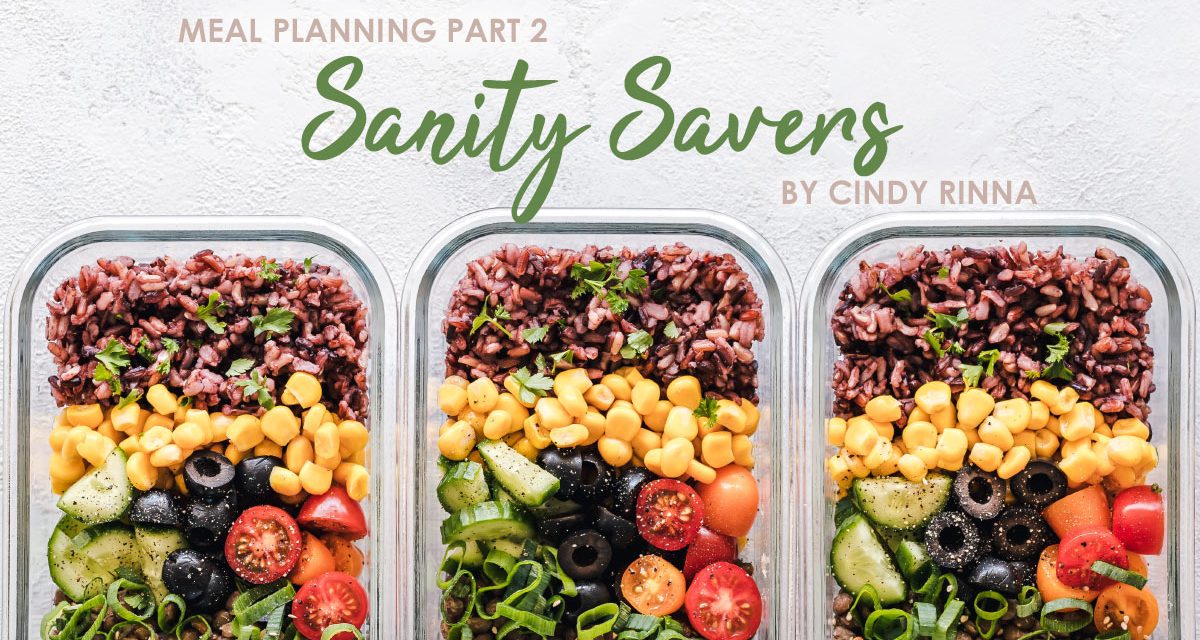Sanity savers
Now for some tried and true tips that I’ve picked up along the way. These will save you time and sanity…
Cook once, eat twice
Cook or bake whatever you can in a double batch. Leftovers can be enjoyed for the following lunch or frozen. Once you have a stockpile in your freezer you can use that food for “free-for-all” Friday or have something ready when you need to bring a meal to a friend who is sick, going through a difficult loss, or just had a new baby.
Use the whole chicken
Step 1: Bake a whole chicken (or two) and serve for dinner
Try it with baked potatoes and asparagus
Step 2: Shred the remaining meat to use in a soup, chili, casserole, or stir-fry. If you have nothing
coming up in the next couple of days in your meal plan, portion out 2 cups and freeze it.
Some ideas are chicken noodle, chicken chili, or chicken vegetable soup
Step 3: Make broth out of the carcass
Place carcass in your crock pot. Add a carrot stalk, celery stalk, and half an onion. Fill the crock pot with water. Cook on low for 24 – 36 hours. The longer you cook, the richer the broth. Broth can be frozen or used within 24 hours. If you freeze it, be sure to freeze it in
measurements from your favorite recipes. Many soups need 2 quarts of broth. You can
also use broth to replace water when making rice to add extra flavor. Don’t forget to freeze some in ice cube trays to use when reheating dishes.
Marinade while making coffee
If you have meat that needs to marinade for dinner, do it while your coffee brews. It only takes a minute.
Start your crock pot after breakfast
Most crock pot recipes cook for 6-8 hours on low. That means if you want to eat dinner around 5, 9 a.m. is your cut off for starting. If it’s ready early, you can always set the crock pot to “keep warm” so you don’t dry out your meal.
Use paper plates at lunch
This might apply more to a large family. If you are sitting down for breakfast and lunch and dinner, that’s a lot of dishes to do. Run your dishwasher after breakfast and use paper at lunch so you don’t have to do another load before dinner.
Have a specified snack menu
There’s no doubt your family will need a snack or two in between breakfast, lunch, and dinner. If you have tween or teen boys in the house it won’t surprise you to hear that what they consider a “snack” could very well be your plan for dinner that night. If you have a designated snack area in your pantry and fridge or at least a general understanding of what constitutes a “snack” it’ll save your meal plan. Snacks are free-game in between meals and sometimes I will prepare them. Snack time is around 10 a.m.and then again at 3 p.m. Oftentimes, I’ll bake something like muffins or cookies for tea time and of course, something warm to sip on like tea, warm milk, or cocoa.
Cook – prep – cook
Try not to cook back-to-back meals or you’ll end up in the kitchen all day fixing a meal, cleaning up a meal, and finding it’s time to fix a meal again. For example…
Breakfast: Waffles (bake)
Snack: Kids choice (no prep or cooking)
Lunch: Sandwiches, carrot sticks & chips (minimal prep)
Tea Time: Scones (bake)
Dinner: Chili (crock pot)
Or, if I know I have a big dinner to make that night, I’ll do an easy breakfast and be sure to do something pre-made for tea time.
Have a theme
Winter is full of baked goods and soups. Spring is for trying out fresh new recipes. Summer brings salads and grilling out. In autumn, cinnamon and nutmeg seem to find their way into everything from muffins to soups. In-season produce is the focus that helps create food to entice the senses of that time of year.
Be predictable
Muffins on Monday. Waffle Wednesday. Taco Tuesday. Wildcard Wednesday. Free-for-all Friday. Kid of the Week’s Saturday pick. Put all of these together (or invent your own!) and you’ve got a pretty good template to get you through the week. Too much decision making can leave us fatigued and distract us from more important things. In my family we’ve found that a seasonal meal plan is just the right amount of time to enjoy the benefits of predictability without becoming so repetitive that people groan when they realize it’s “Spaghetti Sunday”…again.
Teach your kids to cook…young
Cooking together is not only great for your relationship but it helps you get dinner prepped more quickly. Kids as young as four or five may be ready to gather ingredients, crack eggs, whisk dry ingredients, stir something in a pan, start the mixer, pour wet ingredients, and even chop veggies. Use caution and discretion, of course. It will take you extra time but will nurture their little souls and give them excellent practice at an essential skill.
For the nights it’s just not going to happen
No matter how you plan, there will be times where the day gets away and you realize you have nothing for dinner. On those nights you can…
- Check the freezer – do you have anything you can pull from your stockpile?
- Have breakfast for dinner (or lunch) – kids get a kick out of things being out of order even if it stresses you out. Have omelets or sandwiches for dinner instead.
- Still gather together. Remember, it’s more about relationships than food. Even if you are laying your table with cheese and crackers and apple slices, be sure to go through the motions of a normal dinner. Turn on some quiet music, light a couple of candles, and dig in. Setting time aside in everyone’s busy day for conversation and connection will be well worth it.





